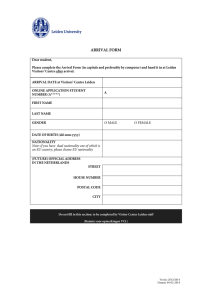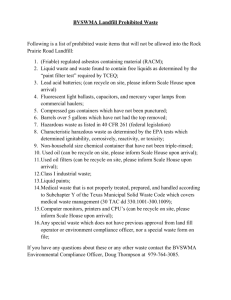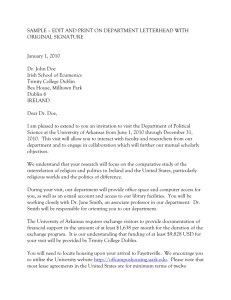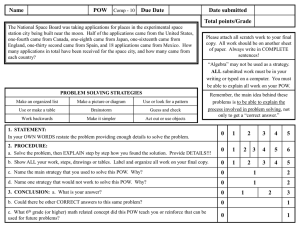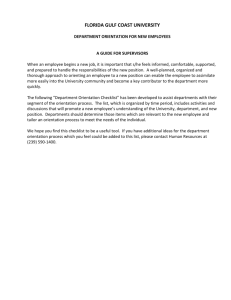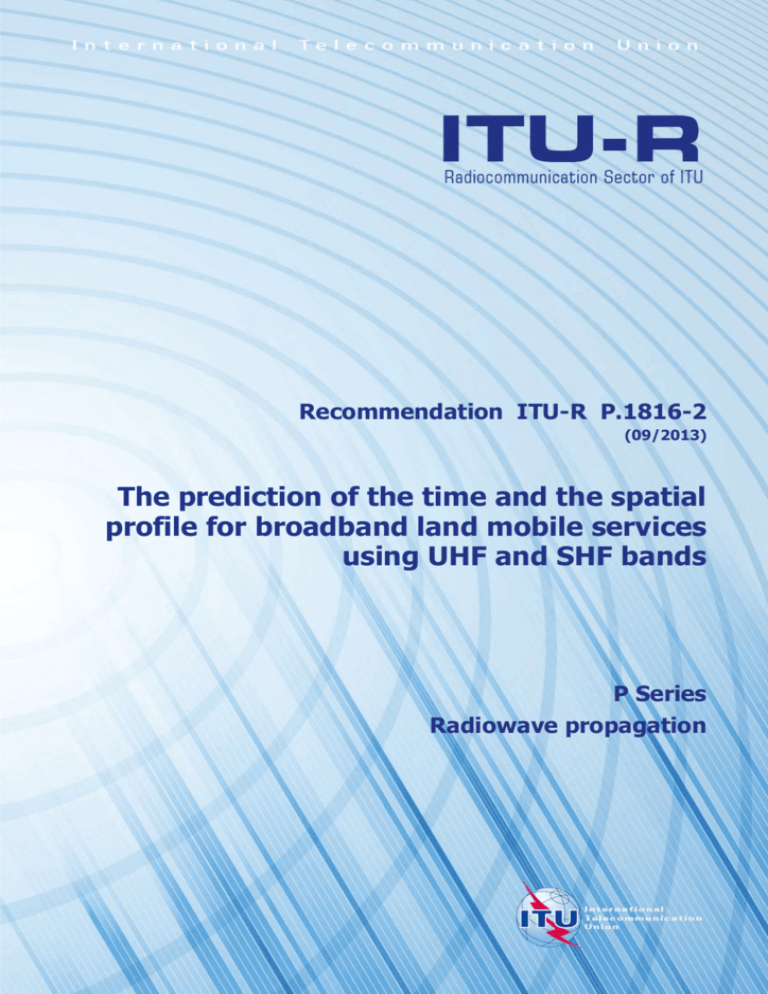
Recommendation ITU-R P.1816-2
(09/2013)
The prediction of the time and the spatial
profile for broadband land mobile services
using UHF and SHF bands
P Series
Radiowave propagation
ii
Rec. ITU-R P.1816-2
Foreword
The role of the Radiocommunication Sector is to ensure the rational, equitable, efficient and economical use of the
radio-frequency spectrum by all radiocommunication services, including satellite services, and carry out studies without
limit of frequency range on the basis of which Recommendations are adopted.
The regulatory and policy functions of the Radiocommunication Sector are performed by World and Regional
Radiocommunication Conferences and Radiocommunication Assemblies supported by Study Groups.
Policy on Intellectual Property Right (IPR)
ITU-R policy on IPR is described in the Common Patent Policy for ITU-T/ITU-R/ISO/IEC referenced in Annex 1 of
Resolution ITU-R 1. Forms to be used for the submission of patent statements and licensing declarations by patent
holders are available from http://www.itu.int/ITU-R/go/patents/en where the Guidelines for Implementation of the
Common Patent Policy for ITU-T/ITU-R/ISO/IEC and the ITU-R patent information database can also be found.
Series of ITU-R Recommendations
(Also available online at http://www.itu.int/publ/R-REC/en)
Series
BO
BR
BS
BT
F
M
P
RA
RS
S
SA
SF
SM
SNG
TF
V
Title
Satellite delivery
Recording for production, archival and play-out; film for television
Broadcasting service (sound)
Broadcasting service (television)
Fixed service
Mobile, radiodetermination, amateur and related satellite services
Radiowave propagation
Radio astronomy
Remote sensing systems
Fixed-satellite service
Space applications and meteorology
Frequency sharing and coordination between fixed-satellite and fixed service systems
Spectrum management
Satellite news gathering
Time signals and frequency standards emissions
Vocabulary and related subjects
Note: This ITU-R Recommendation was approved in English under the procedure detailed in Resolution ITU-R 1.
Electronic Publication
Geneva, 2013
ITU 2013
All rights reserved. No part of this publication may be reproduced, by any means whatsoever, without written permission of ITU.
Rec. ITU-R P.1816-2
1
RECOMMENDATION ITU-R P.1816-2
The prediction of the time and the spatial profile for broadband land
mobile services using UHF and SHF bands
(Question ITU-R 211/3)
(2007-2012-2013)
Scope
The purpose of this Recommendation is to provide guidance on the prediction of the time and the spatial
profile for broadband land mobile services using the frequency range 0.7 GHz to 9 GHz for distances from
0.5 km to 3 km for non-line of sight (NLoS) environments and from 0.05 km to 3 km for line of sight (LoS)
environments in both urban and suburban environments.
The ITU Radiocommunication Assembly,
considering
a)
that there is a need to give guidance to engineers in the planning of broadband mobile
services in the UHF and SHF bands;
b)
that the time-spatial profile can be important for evaluating the influence of multipath
propagation;
c)
that the time-spatial profile can best be modelled by considering the propagation conditions
such as building height, antenna height, distance between base station and mobile station, and
bandwidth of receiver,
noting
a)
that the methods of Recommendation ITU-R P.1546 are recommended for point-to-area
prediction of field strength for the broadcasting, land mobile, maritime and certain fixed services in
the frequency range 30 MHz to 3 000 MHz and for the distance range 1 km to 1 000 km;
b)
that the methods of Recommendation ITU-R P.1411 are recommended for the assessment
of the propagation characteristics of short-range (up to 1 km) outdoor systems between 300 MHz
and 100 GHz;
c)
that the methods of Recommendation ITU-R P.1411 are recommended for estimating the
average shape of the delay profile for the line-of-sight (LoS) case in an urban high-rise environment
for micro-cells and pico-cells;
d)
that the methods of Recommendation ITU-R P.1407 are recommended for specifying the
terminology of multipath and for calculating the delay spread and the arrival angular spread by
using the delay profile and the arrival angular profile, respectively;
e)
that the methods of Recommendation ITU-R M.1225 are recommended for evaluating the
IMT-2000 system performance affected by multipath propagation,
recommends
1
that the content of Annex 1 should be used for estimating the long-term envelope and
power delay profiles for broadband mobile services in urban and suburban areas using the UHF and
SHF bands;
2
Rec. ITU-R P.1816-2
2
that the content of Annex 2 should be used for estimating the long-term power arrival
angular profile at the BS (base station) for broadband mobile services in urban and suburban areas
using the UHF and SHF bands;
3
that the content of Annex 3 should be used for estimating the long-term power arrival
angular profile at the MS (mobile station) for broadband mobile services in urban and suburban
areas using the UHF and SHF bands.
Annex 1
1
Introduction
The importance of the delay profile is indicated in Recommendation ITU-R P.1407 as follows.
Multipath propagation characteristics are a major factor in controlling the quality of digital mobile
communications. Physically, multipath propagation characteristics imply multipath number,
amplitude, path-length difference (delay), and arrival angle. These can be characterized by the
transfer function of the propagation path (amplitude-frequency characteristics), and the correlation
bandwidth.
As mentioned, the delay profile is a fundamental parameter for evaluating the multipath
characteristics. Once the profile is modeled, multipath parameters such as delay spread and
frequency correlation bandwidth can be derived from the profile.
Propagation parameters related to the path environment affect the shape of the profile. A profile is
formed by multiple waves that have different amplitudes and different delay times. It is known that
long delayed waves have low amplitude because of the long path travelled. The averaged delay
profile (long-term delay profile) can be approximated as an exponential or power functions as
shown in previous works.
Both the number and the period of arriving waves in a delay profile depend on the receiving
bandwidth because the time resolution is limited by the frequency bandwidth of the receiver.
In order to estimate the delay profile, the limitation of frequency bandwidth should be considered.
This limitation is closely related to the method used to divide the received power into multiple
waves.
In order to take the frequency bandwidth or path resolution into consideration, the delay profile
consisting of discrete paths is defined as the path delay profile.
In Recommendation ITU-R P.1407, various delay profiles and their processing methods are defined
as shown in Fig. 1.
Instantaneous power delay profile is the power density of the impulse response at one moment at
one point. Short-term power delay profiles are obtained by spatial averaging the instantaneous
power delay profiles over several tens of wavelengths in order to suppress the variation of rapid
fading; long-term power delay profiles are obtained by spatial averaging the short-term power delay
profiles at the approximately the same distance from the base station (BS) in order to also suppress
the variations due to shadowing.
With regard to the long-term delay profile, two different profiles can be defined. One, the envelope
delay profile, is based on the median value of each delay profile; it expresses the shape of the
Rec. ITU-R P.1816-2
3
profile at the area being considered as shown in Fig. 1. The other is the power delay profile based
on the average power value of each delay profile.
Furthermore, with regard to the long-term envelope and power delay profiles, path delay profiles
consisting of discrete paths are also defined in order to obtain the variation in path number with
path resolution, which depends on the frequency bandwidth.
FIGURE 1
Delay profiles
Power
Distance (m)
Long-term
envelope delay profile
Distance (m)
Long-term
envelope path delay profile
Dt
Averaging
Delay time
Path
Median
Instantaneous
power delay profile
Delay time
Delay time
Averaging
Short-term
power delay profile
Delay time
Dt
Delay time
Long-term
power delay profile
Path
Delay time
Long-term
power path delay profile
P.1816-01
2
Parameters
t:
i:
<H> :
hb :
d:
W:
B:
f:
<R> :
dB :
:
DL :
excess delay time, (s)
excess delay time normalized by time resolution 1/B and i = 0, 1, 2,…
(here i = 0 means the first arrival path without excess delay time and i = k
means excess delay time of k/B (s))
average building height (5-50 m: height above the mobile station ground level),
(m)
base station antenna height (5-150 m: height above the mobile station ground
level), (m)
distance from the base station (0.5-3 km for NLoS environment, 0.05-3 km for
LoS environment), (km)
street width (5-50 m), (m)
chip rate (0.5-50 Mcps), (Mcps)
(occupied bandwidth can be converted from chip rate B and applied baseband
filter)
carrier frequency (0.7-9 GHz), (GHz)
average power reflection coefficient of building side wall, (<1)
constant value (−16 dB-−12 dB), (dB)
10dB / 10
the level difference between the peak path’s power and cut-off power, (dB).
4
Rec. ITU-R P.1816-2
3
Long-term delay profile for NLoS environment in urban and suburban areas
3.1
Envelope delay profile normalized by the first arrival path’s power
The envelope path delay profile PDPNLoS ,env i, d divided by time resolution 1/B normalized by the
first arrival path’s power at distance d is given as follows:
PDPNLoS ,env (i, d ) 10 PDPdB (i ,d ) /10
(1)
where:
PDPdB (i, d ) a(i) PDPhigh (i, d )
PDPhigh i, d 19.1 9.68 log h / H
(dB)
B0.360.12 logh
b
/ H
(2)
d 0.38 0.21 log B log 1 i (dB) (2-1)
ai 0.4 1 0.4 exp 0.2 H / hb 4 H / hb 1 exp 0.4 H / hb 2 i / B
(2-2)
The envelope delay profile PDPNLoS ,env t, d
with continuous excess delay time normalized by the first arrival path’s power at distance d is
given as follows:
PDPNLoS ,env t, d PDPNLoS ,env Bt, d
(3)
In deriving equation (3), the relation t i / B i Bt is used.
3.2
Power delay profile normalized by the first arrival path’s power
The power path delay profile PDPNLoS , pow i, d divided by time resolution 1/B normalized by the
first path’s power at distance d is given as follows:
PDPNLoS , pow i, d c(i) 10PDPdB (i ,d ) /10
(4)
where:
(i 0)
1
ci
0.077 0.00096 B 0.0014 0.000018 B H i
min 0.63, 0.59e 0.0172 B 0.0172 0.0004 B H e
(i 0)
(5)
Here, function min(x, y) selects the minimum value of x and y.
The power delay profile PDPNLoS , pow t, d with continuous excess delay time normalized by the first
arrival path’s power at distance d is given as follows:
PDPNLoS , pow t, d PDPNLoS , pow Bt, d
(6)
Rec. ITU-R P.1816-2
5
3.3
Examples
3.3.1
Envelope delay profile normalized by the first arrival path’s power
When base station antenna height hb, distance from the base station d and average building height
<H> are 50 m, 1.5 km and 20 m, respectively, the envelope path delay profile PDPNLoS ,env i, d
is shown in Fig. 2, where the parameter is the chip rate B.
When average building height <H>, distance from the base station d and chip rate B are 20 m,
1.5 km and 10 Mcps, respectively, the envelope delay profile PDPNLoS ,env t, d is shown in Fig. 3,
where the parameter is the base station antenna height, hb.
FIGURE 2
Envelope path delay profile
PDPNLoS ,env i, d
for NLoS environments
0
Relative power (dB)
B = 50 Mcps
B = 30 Mcps
–10
<H> = 20 m
hb = 50 m
d = 1.5 km
–20
B = 10 Mcps
–30
0
10
20
30
40
50
Path number
P.1816-02
FIGURE 3
Envelope delay profile
PDPNLoS ,env t, d
for NLoS environments
Relative power (dB)
0
<H> = 20 m
B = 10 Mcps
d = 1.5 km
hb = 50 m
–10
–20
hb = 10 m
hb = 20 m
–30
0
1
2
3
4
5
Excess delay time ( s)
P.1816-03
6
3.3.2
Rec. ITU-R P.1816-2
Power delay profile normalized by the first arrival path’s power
When base station antenna height hb, distance from the base station d and average building height
<H> are 50 m, 1.5 km and 20 m, respectively, the power path delay profile PDPNLoS , pow i, d
is shown in Fig. 4, where the parameter is the chip rate B.
When average building height <H>, distance from the base station d and chip rate B are 20 m,
1.5 km and 10 Mcps, respectively, the power delay profile PDPNLoS , pow t, d is shown in Fig. 5,
where the parameter is the base station antenna height hb.
FIGURE 4
Power path delay profile
PDPNLoS , pow i, d
for NLoS environments
0
Relative power (dB)
B = 50 Mcps
B = 30 Mcps
–10
–20
<H> = 20 m
hb = 50 m
d = 1.5 km
B = 10 Mcps
–30
0
10
20
30
40
50
Path number
P.1816-04
FIGURE 5
Power delay profile
PDPNLoS , pow t, d
for NLoS environments
Relative power (dB)
0
<H> = 20 m
B = 10 Mcps
d = 1.5 km
hb = 50 m
–10
hb = 20 m
–20
hb = 10 m
–30
0
1
2
3
4
5
Excess delay time ( s)
Relative power (dB)
0
B = 10 Mcps
hb = 50 m
d = 1.5 km
<H> = 30 m
–10
<H> = 20 m
–20
<H> = 10 m
–30
0
1
2
3
4
5
Excess delay time (µs)
P.1816-05
P.1816-05
Rec. ITU-R P.1816-2
7
4
Long-term delay profile for LoS environment in urban and suburban areas
4.1
LoS environments considered
Figure 6 shows the LoS environments considered. In Fig. 6(a), the BS is located on the top of the
building facing the left or right side of the street and the MS is on the middle of the street and the
BS can directly observe the MS. In Fig. 6(b), the BS is located roughly at the centre of the rooftop
of a building facing the end of the street and the MS is in the middle of the street.
FIGURE 6
LoS environments considered
Building
facing the
left side of
the street
BS
BS
MS
Building
facing the
right side
of the street
MS
(a) BS facing the left or right side of the street
BS
Building
facing
the end
of the
street
MS
(b) BS facing the end of the street
P.1816-06
Envelope delay profile normalized by the first arrival path’s power
4.2
The envelope delay profile PDPLoS , env t, d normalized by the first arrival path’s power at
distance d is given as follows:
a)
BS facing the left or right side of the street
PDPLoS ,env t, d R
b)
181000d
300t / W 2 1
PDPNLoS,env t,d
2
(7-1)
BS facing the end of the street
PDPLoS ,env t, d R
R
2 1000d
300t / W 2
181000d
300t / W 2 1
2
2 e 521000d 300t / W PDPNLoS ,env t, d
PDPNLoS ,env t, d
2
(7-2)
8
Rec. ITU-R P.1816-2
Here, PDPNLoS ,env t, d is the envelope delay profile for NLoS environments given in equation (3)
normalized by the first arrival path’s power at distance d. is a constant value of −12 dB to −16 dB
according to the city structure. <R> is the average power reflection coefficient of building side wall
and is a constant value of 0.1 to 0.5.
and <R> are recommended to be −15 dB and 0.3 (−5 dB), respectively, for urban areas where the
average building height <H> is higher than 20 m.
4.3
Power delay profile normalized by the first arrival path’s power
The power delay profile PDPLoS , env t, d normalized by the first path’s power at distance d is given
as follows:
a)
BS facing the left or right side of the street
PDPLoS , pow t, d R
b)
(8-1)
BS facing the end of the street
PDPLoS , pow t, d R
R
181000d
300t / W 2 1
PDPNLoS, pow t,d
2
2 1000d
300t / W 2
181000d
300t / W 2 1
2
2 e 521000d 300t / W PDPNLoS , pow t, d
2
PDPNLoS , pow t, d
(8-2)
Here, PDPNLoS , pow t, d is the power delay profile for NLoS environments given in equation (6)
normalized by the first arrival path’s power at distance d. is a constant value of −12 dB to −16 dB
according to the city structure. <R> is the average power reflection coefficient of building side wall.
and <R> are recommended to have values of −15 dB and 0.3 (−5dB), respectively, in urban areas
where the average building height <H> is higher than 20 m.
4.4
Examples
4.4.1
Envelope delay profile normalized by the first arrival path’s power
When base station antenna height hb, average building height <H>, chip rate B, and <R> are 50 m,
20 m, 10 Mcps, −15 dB and 0.3 (−5 dB), respectively, the envelope delay profile PDPLoS , env t, d
follows that shown in Fig. 7, where the parameter is the distance from the base station d.
Rec. ITU-R P.1816-2
9
FIGURE 7
Envelope delay profile PDPLoS ,env t, d
for LoS environments
0
d = 0.1 km
–10
d = 0.2 km
hb = 50 m
<H> = 20 m
W = 20 m
B = 10 Mcps
<R > = 0.3 (–5 dB)
Relative power (dB)
Relative power (dB)
0
= –15 dB
–20
–30
d = 0.1 km
–10
d = 0.2 km
hb = 50 m
<H> = 20 m
W = 20 m
B = 10 Mcps
<R > = 0.3 (–5 dB)
= –15 dB
–20
–30
0
0.1
0.2
0.3
0.4
0.5
0
0.1
0.2
0.3
0.4
0.5
Excess delay time ( s)
Excess delay time ( s)
(a) BS facing the left or right side of the street
(b) BS facing the end of the street
P.1816-07
4.4.2
Power delay profile normalized by the first arrival path’s power
When base station antenna height hb, average building height <H>, chip rate B, and <R> are 50 m,
20 m, 10 Mcps, −15 dB and 0.3 (−5 dB), respectively, the power delay profile PDPLoS , pow t, d
follows that shown in Fig. 8, where the parameter is the distance from the base station d.
FIGURE 8
Power delay profile PDPLoS , pow t, d for LoS environments
0
d = 0.1 km
–10
d = 0.2 km
hb = 50 m
<H> = 20 m
W = 20 m
B = 10 Mcps
<R > = 0.3 (–5 dB)
Relative power (dB)
Relative power (dB)
0
= –15 dB
–20
–30
d = 0.1 km
–10
d = 0.2 km
hb = 50 m
<H> = 20 m
W = 20 m
B = 10 Mcps
<R> = 0.3 (–5 dB)
= –15 dB
–20
–30
0
0.1
0.2
0.3
0.4
0.5
0
0.1
0.2
0.3
0.4
0.5
Excess delay time ( s)
Excess delay time ( s)
(a) BS facing the left or right side of the street
(b) BS facing the end of the street
P.1816-08
10
Rec. ITU-R P.1816-2
Annex 2
1
Introduction
The importance of the arrival angular profile is indicated in Recommendation ITU-R P.1407
as follows.
Multipath propagation characteristics are a major factor in controlling the quality of digital mobile
communications. Physically, multipath propagation characteristics imply multipath number,
amplitude, path-length difference (delay), and arrival angle. These can be characterized by the
transfer function of the propagation path (amplitude-frequency characteristics), and the correlation
bandwidth.
As mentioned, the arrival angular profile is a fundamental parameter for evaluating the multipath
characteristics. Once the profile is modelled, multipath parameters such as arrival angular spread
and spatial correlation distance can be derived from the profile.
Propagation parameters related to the path environment affect the shape of the profile. A profile is
formed by multiple waves that have different amplitudes and different arrival angle. It is known that
waves with large arrival angles have low amplitude because of the long path travelled.
The averaged arrival angular profile (long-term arrival angular profile) at a base station (BS)
is approximated as Gaussian or Laplacian (both side exponential) functions in previous works.
In Recommendation ITU-R P.1407, various arrival angular profiles and their processing methods
are defined. By referring Recommendation ITU-R P.1407, the arrival angular profile at the BS is
defined as shown in Fig. 9. The instantaneous power arrival angular profile is the power density of
the impulse response regarding the arrival angle at one moment at one point. The short-term power
arrival angular profile is obtained by spatially averaging the instantaneous power arrival angular
profiles over several tens of wavelengths in order to suppress the variations due to rapid fading;
long-term power arrival angular profile is obtained by spatially averaging the short-term power
arrival angular profiles at approximately the same distance from the base station (BS) in order to
suppress the variation due to shadowing.
FIGURE 9
Arrival angular profiles at BS
Power
Distance (m)
Long-term
envelope angular profile
Long-term
envelope path angular profile
Distance (m)
Path
Dq
Averaging
Median
Arrival angle
Arrival angle
Instantaneous
power angular profile
Averaging
Arrival angle
Short-term
power angular profile
Arrival angle
Long-term
power angular profile
Arrival angle
Dq
Path
Arrival angle
Long-term
power path angular profile
P.1816-09
Rec. ITU-R P.1816-2
2
11
Parameters
hb : base station antenna height (20-150 m: height above the mobile station ground
level), (m)
<H>: average building height (5-50 m: height above the mobile station ground level),
(m)
d : distance from the base station (0.5-3 km for NLoS environment, 0.05-3 km for
LoS environment), (km)
W : street width (5-50 m), (m)
B : chip rate (0.5-50 Mcps), (Mcps)
(occupied bandwidth can be converted from chip rate B and applied baseband
filter)
f : carrier frequency (0.7-9 GHz), (GHz)
<R> : average power reflection coefficient of building side wall (< 1)
dB :
:
DL :
constant value (−16 dB-−12 dB), (dB)
10dB / 10
the level difference between the peak path’s power and cut-off power, (dB).
3
Long-term arrival angular profile at BS for NLoS environment in urban and
suburban areas
3.1
Arrival angular profile at BS normalized by the maximum path’s power
The power arrival angular profile at the BS, AODNLoS , pow (Dq, d ) normalized by the maximum
path’s power at distance d is given as follows:
Dq
AODNLoS ,pow (Dq, d ) 1
a
(
d
)
– ( d )
(9)
where:
H 0.23
a d 0.2d 2.1
hb
d 0.015 H 0.63d 0.16 0.76 log hb
(10)
The maximum arrival angle at the BS, aM (degrees), is represented as follows:
aM d
(11)
12
Rec. ITU-R P.1816-2
where and are constants and represented as functions of base station antenna height, hb,
the average building height, <H>, and the threshold level DL (dB) as follows:
H
2.66 0.18DL
7.67 0.98DL exp
hb
7
DL 15
DL 15
(12)
H
35.8 41.1 log( DL) exp
1.76 0.034DL
hb
From the empirical studies, equation (9) is applied for carrier frequencies between 0.7 GHz and
9 GHz.
3.2
Example
When base station antenna height, hb, and distance from the base station, d, are 50 m and 1.5 km
respectively, the power arrival angular profile at the BS, AODNLoS , pow Dq, d for NLoS environments
is shown in Fig. 10, where the parameter is the average building height <H>.
FIGURE 10
Arrival angular profile at BS for NLoS environments
Relative power
1
0.1
0.01
0.001
–30
–20
–10
0
10
20
30
Arrival angle (degrees)
<H> = 10 m hb = 50 m
<H> = 20 m d = 1.5 km
<H> = 30 m
P.1816-10
4
Long-term arrival angular profile at BS for LoS environment in urban and suburban
areas
4.1
LoS environments considered
Figure 11 shows the LoS environments considered. In Fig. 11(a), the BS is located on the top of a
building facing the left or right side of the street and the MS is in the middle of the street; the BS
has a direct line of sight to the MS. In Fig. 11(b), the BS is located roughly at the centre of the
rooftop of a building facing the end of the street and the MS is in the middle of the street.
Rec. ITU-R P.1816-2
13
FIGURE 11
LoS environments considered
Building
facing the
left side of
the street
BS
BS
MS
Building
facing the
right side
of the street
MS
(a) BS facing the left or right side of the street
BS
Building
facing
the end
of the
street
MS
(b) BS facing the end of the street
P.1816-11
4.2
Arrival angular profile at BS normalized by the maximum path’s power
The power arrival angular profile at the BS, AODLoS , pow Dq, d normalized by the maximum
path’s power at distance d is given as follows:
a)
BS facing the left or right side of the street
i)
BS facing the right side of the street as shown in Fig. 11(a)
AODNLoS , pow Dq, d
AODLoS , pow Dq, d 1000d Dq /(180W )
AODNLoS , pow Dq, d
R
Dq 0
Dq 0
(13-1)
Dq 0
Dq 0
(13-2)
ii) BS facing the left side of the street as shown in Figure 11(a)
R 1000d Dq /(180W ) AOD
NLoS , pow Dq, d
AODLoS , pow Dq, d
AODNLoS , pow Dq, d
b)
BS facing the end of the street
AODLoS , pow Dq, d R
1000d Dq /(180W )
AODNLoS , pow Dq, d
(13-3)
14
Rec. ITU-R P.1816-2
Here, AODNLoS , pow Dq, d is the arrival angular profile at the BS for NLoS environments given in
equation (9) normalized by the maximum path’s power at distance d. is a constant value of −12 dB
to −16 dB according to the city structure. <R> is the average power reflection coefficient of
building side wall and is a constant value of 0.1 to 0.5. Note that equation (13-1) and
equation (13-2) are perfectly symmetric about the arrival angle at the BS.
and <R> are recommended to have values of −15 dB and 0.3 (−5 dB), respectively, in urban areas
where the average building height <H> is higher than 20 m.
4.3
Examples
When base station antenna height hb, average building height <H> and street width W are 50 m,
30 m and 20 m, respectively, and <R> and are 0.3 (−5 dB) and –15 dB, respectively, the power
arrival angular profiles at the BS, AOD LoS , pow Dq, d in the case of Fig. 11 for LoS environments
are shown in Fig. 12, where the parameter is the distance from the base station d.
FIGURE 12
Arrival angular profile at BS AODLoS , pow Dq, d for LoS environments
0
hb = 50 m
<H> = 20 m
W = 20 m
<R> = 0.3 (–5 dB)
= –15 dB
–10
d = 0.1 km
d = 0.1 km
Relative power (dB)
Relative power (dB)
0
–20
d = 0.2 km
–10
hb = 50 m
<H> = 20 m
W = 20 m
<R > = 0.3 (–5 dB)
= –15 dB
–20
d = 0.2 km
–30
–30
–40
–20
0
20
40
–40
–20
0
20
40
Arrival angle (deg.)
Arrival angle (deg.)
(a) BS facing the left or right side of the street
(b) BS facing the end of the street
P.1816-12
Annex 3
1
Introduction
The arrival angular profile at a mobile station (MS) is defined as shown in Fig. 13 by referring to
Recommendation ITU-R P.1407. The instantaneous power arrival angular profile is the power
density of the impulse response regarding the arrival angle at one moment at one point. The
short-term power arrival angular profile is obtained by spatially averaging the instantaneous power
arrival angular profiles over several tens of wavelengths in order to suppress the variations due to
rapid fading; the long-term power arrival angular profile is obtained by spatially averaging the
short-term power arrival angular profiles at approximately the same distance from the base station
(BS) in order to suppress the variation due to shadowing.
Rec. ITU-R P.1816-2
15
FIGURE 13
Arrival angular profiles at MS
Distance (m)
Long-term envelope
arrival angular profile at MS
Long-term envelope path
arrival angular profile at MS
Power
Distance (m)
Dq’
Averaging
Arrival angle
Path
Median
Arrival angle
Instantaneous power arrival
angular profile at MS
Averaging
Arrival angle
Short-term power
arrival angular profile at MS
Arrival angle
Long-term power
arrival angular profile at MS
Dq’
Arrival angle
Path
Arrival angle
Long-term power path
arrival angular profile at MS
P.1816-13
2
Parameters
hb : base station antenna height (20-150 m: height above the mobile station ground
level), (m)
<H>: average building height (5-50 m: height above the mobile station ground level),
(m)
d : distance from the base station (0.5-3 km), (km)
W : street width (5-50 m), (m)
B : chip rate (0.5-50 Mcps), (Mcps)
(occupied bandwidth can be converted from chip rate B and applied baseband
filter)
f : carrier frequency (0.7-9 GHz), (GHz)
:
hs :
'
<R>:
dB :
:
the road angle (0-90 degrees: the acute angle between the direction of the MS
and the direction of the road), (degrees)
the average height of the buildings along the road (4-30 m), (m)
arrival angle (−180-180 degrees: arrival angle when the road angle is set to
0 degrees), (degree)
average power reflection coefficient of building side wall (< 1)
constant value (−16 dB – −12 dB), (dB)
10dB / 10 .
3
Long-term arrival angular profile at MS for NLoS environments in urban and
suburban areas
3.1
Arrival angular profile at MS
The power arrival angular profile at the MS, AOANLoS , pow ' is given as follows:
16
Rec. ITU-R P.1816-2
AOANLoS , pow '
1
2
(14)
2
2
cos '
sin '
/
180
180
where:
1.5
Min 1, 2.6 / hs0.5 1 exp 0.03 0.05
3.2
(15)
Example
When the average height of the buildings along the road, hs, is 10 m, the power arrival angular
profile at the MS, AOANLoS , pow ' is shown in Fig. 14, where the parameter is road angle .
FIGURE 14
Arrival angular profile at MS for NLoS environments
Relative received power (dB)
0
hs = 10 m
= 90 degrees
–10
–20
–30
= 15 degrees
–40
–180
–135
–90
–45
= 0 degrees
0
45
90
135
180
Arrival angle (degrees)
P.1816-14
4
Long-term arrival angular profile at MS for LoS environment in urban and suburban
areas
4.1
LoS environments considered
Figure 15 shows the LoS environments considered. In Fig. 15(a), the BS is located on the top of
a building facing the left or right side of the street and the MS is in the middle of the street; the BS
has a direct line of sight to the MS. In Fig. 15(b), the BS is located roughly at the centre of the
rooftop of a building facing the end of the street and the MS is in the middle of the street.
Rec. ITU-R P.1816-2
17
FIGURE 15
LoS environments considered
Building
facing the
left side of
the street
BS
BS
MS
Building
facing the
right side
of the street
MS
(a) BS facing the left or right side of the street
BS
Building
facing
the end
of the
street
MS
(b) BS facing the end of the street
P.1816-15
4.2
Arrival angular profile at MS
The power arrival angular profile at the MS, AOALoS , pow ' , d is given as follows:
a)
BS facing the left or right side of the street
i)
BS facing the right side of the street as shown in Fig. 15(a)
R
AOALoS , pow ' , d
R
1000d ' /(180W )
AOANLoS , pow '
(1000d ' /(180W )) 1
AOANLoS , pow '
' 0
' 0
(16-1)
ii) BS facing the left side of the street as shown in Fig. 15(a)
R
AOALoS , pow ' , d
R
b)
(1000d ' /(180W )) 1
1000d ' /(180W )
AOANLoS , pow '
AOANLoS , pow '
' 0
' 0
(16-2)
BS facing the end of the street
AOALoS , pow ' , d R
1000d ' /(180W )
AOANLoS, pow '
(16-3)
18
Rec. ITU-R P.1816-2
Here, AOANLoS , pow ' , d is the arrival angular profile at the MS for NLoS environments given in
equation (14). is a constant value of −12 dB to −16 dB according to the city structure. <R> is the
average power reflection coefficient of building side wall and is a constant value of 0.1 to 0.5. Note
that equation (16-1) and equation (16-2) are perfectly symmetric about the arrival angle at the MS.
and <R> are recommended to have values of −15 dB and 0.3 (−5 dB), respectively, in urban areas
where the average building height <H> is higher than 20 m.
4.3
Examples
When the average height of the buildings along the road, hs, road angle and street width W are
10 m, 0 degrees and 20 m, respectively, and <R> and are 0.3 (−5 dB) and −15 dB, respectively,
the power arrival angular profiles at the MS, AOALoS , pow ' , d in the case of Fig. 15 for LoS
environments are shown in Fig. 16, where the parameter is the distance from the base station d.
FIGURE 16
Arrival angular profile at MS for LoS environments
–10
0
hs = 10 m
= 0 degrees
W = 20 m
<R> = 0.3 (–5 dB)
= –15 dB
d = 0.1 km
Relative power (dB)
Relative power (dB)
0
d = 0.2 km
–20
–30
–40
–180
–120
–60
0
60
120
180
–10
d = 0.1 km
hs = 10 m
= 0 degrees
W = 20 m
<R> = 0.3 (–5 dB)
= –15 dB
d = 0.2 km
–20
–30
–40
–180
–120
–60
0
60
120
Arrival angle (degrees)
Arrival angle (degrees)
(a) BS facing the left or right side of the street
(b) BS facing the end of the street
180
P.1816-16

